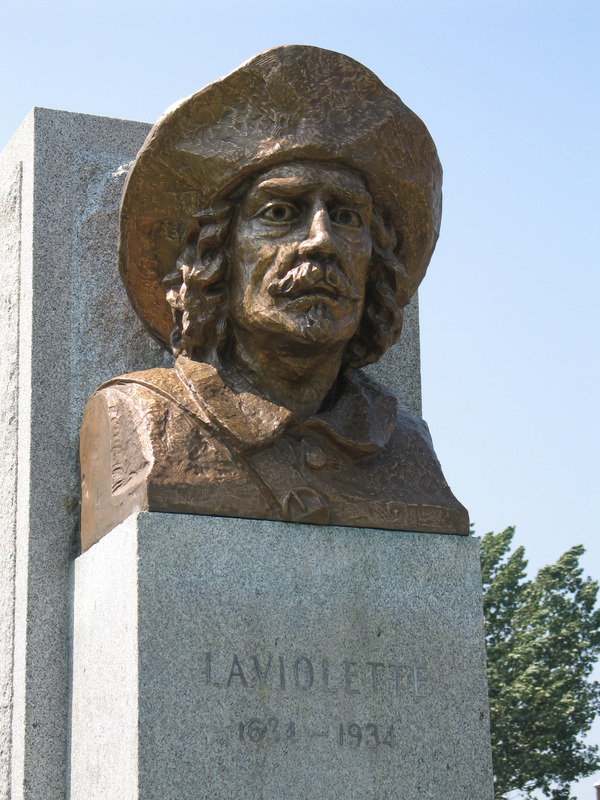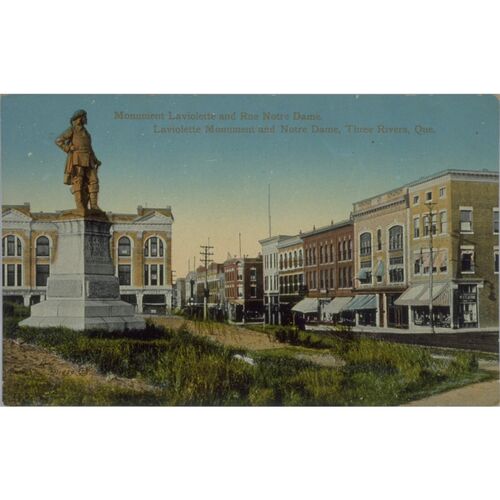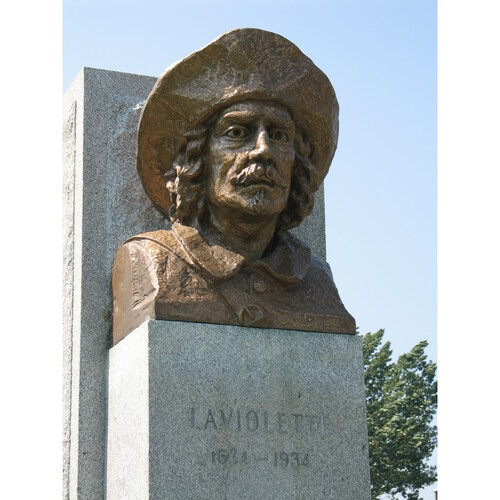
Source: Courtesy of Wikimedia Commons
LAVIOLETTE, first commandant of Trois-Rivières; fl. 1634–36.
The site of Trois-Rivières very early entered history. Jacques Cartier, returning from Hochelaga, had stopped there on 7 Oct. 1535 to explore the mouth of the Saint-Maurice. Shortly before 1600 François Gravé Du Pont, perhaps wanting to find a more suitable trading-post than the one at Tadoussac, or else with the intention of outstripping his competitors, had gone there to meet the Indians. And as early as 1601 Trois-Rivières appeared for the first time on a geographical map (Levasseur’s).
Gravé Du Pont returned there in 1603, together with Champlain. At that period the Indians of the Laurentian coalition (Algonkins, Montagnais, Hurons) were at war with the Iroquois. The latter, making use of the Richelieu River route, were trying to intercept the fur convoys on the St. Lawrence, on their way to Tadoussac. Champlain immediately realized the strategic importance of Trois-Rivières, an advanced post from which one would be able to keep the Iroquois in check and assure unmolested passage along the river for the fur-traders.
However, it was only in 1618 that, for the first time since the founding of Quebec, exchange of furs took place at Trois-Rivières. The same thing occurred in 1620, 1621, and 1622; from 1623 to 1629 the spring fair was held at Cap-de-la-Victoire, near the Richelieu, except in 1624 when it took place at Quebec. In 1632 Trois-Rivières was finally decided upon for the annual meeting between the Indians and the fur-traders.
Champlain had not forgotten his plan of 1603. In 1634 he decided to establish a habitation at Trois-Rivières, prompted by the economic and strategic advantages of the site. He named an employee of the fur trade, called Laviolette, to command the post. Laviolette set out with some artisans and a handful of soldiers, and had a stockade built, within which were erected a few buildings to serve as dwellings and stores. In the same year the Jesuits Paul Le Jeune and Jacques Buteux set up a permanent mission there.
Laviolette commanded at Trois-Rivières from 4 July 1634 to 17 April 1636. That is all we know of him. He probably returned to France at the end of the summer of 1636.
Who is entitled to be called the founder of Trois-Rivières? The majority of historians say that Champlain was the real founder of the post, and Laviolette a subordinate. Was it not Champlain who recognized the economic and strategic importance of the site of Trois-Rivières and who chose the right moment to set it up?
So long as it remained the annual meeting place of traders and Indians, the “town” of Trois-Rivières prospered. But around 1660 it was supplanted by Montreal and began to mark time. In 1666 it had almost as many inhabitants as Montreal and Quebec; at the end of the French régime its population was scarcely greater than in 1666, whereas that of the other two towns had increased tenfold. The Forges Saint-Maurice, which were attempted there in the 18th century, were not enough to fill the gap left by the loss of the fur trade.
Recensement de 1666. Champlain, Œeuvres (Laverdière) JR (Thwaites), IV, 261. L.-P Desrosiers, “Les Trois-Rivières,” Cahiers des Dix, X (1946), 63–95. Sulte, Hist. des Can. fr., II, 48–54.
Cite This Article
André Vachon, “LAVIOLETTE,” in Dictionary of Canadian Biography, vol. 1, University of Toronto/Université Laval, 2003–, accessed December 30, 2025, https://www.biographi.ca/en/bio/laviolette_1E.html.
The citation above shows the format for footnotes and endnotes according to the Chicago manual of style (16th edition). Information to be used in other citation formats:
| Permalink: | https://www.biographi.ca/en/bio/laviolette_1E.html |
| Author of Article: | André Vachon |
| Title of Article: | LAVIOLETTE |
| Publication Name: | Dictionary of Canadian Biography, vol. 1 |
| Publisher: | University of Toronto/Université Laval |
| Year of publication: | 1966 |
| Year of revision: | 1979 |
| Access Date: | December 30, 2025 |




